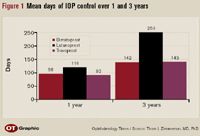Article
Days of IOP control help determine drug effectiveness
Louisville, KY-Monotherapy with latano-prost (Xalatan, Pfizer) provides more days of controlled IOP compared with bimatoprost (Lumigan, Allergan) and travoprost (Travatan, Alcon Laboratories) in patients undergoing treatment for primary open-angle glaucoma (POAG), according to Thom J. Zimmerman, MD, PhD, and colleagues.

"Data from clinical trials on the efficacy of various drug therapies for POAG only partially represent how effective these treatments will be in real-world clinical practice," Dr. Zimmerman said. He is emeritus professor and chairman, Department of Ophthalmology and Visual Sciences and emeritus professor, Department of Pharmacology and Toxicology, University of Louisville, Louisville, KY.
In light of this, Dr. Zimmerman and colleagues conducted a study to show how drug efficacy and patient adherence to therapy combine to determine what they referred to as days of IOP control, which is considered a useful measure of treatment effectiveness in POAG.
The mean patient age was 63 ± 12 years, and the baseline IOP was 25 ± 6 mm Hg. Other data from physician visits included the number of days between visits when the target IOP was not achieved (28), the number of days between visits when the target IOP was achieved (120), and the proportion of physicians who add rather than replace an antiglaucoma drug and gain a 20% to 29% reduction in IOP (40%) and a reduction of 10% to 19% (95%). The days of IOP control were defined as the number of days that a patient's IOP is at or below the physician's target of a 30% reduction from the baseline IOP.
The model included drug efficacy data that were taken from the results of published clinical trials. Patient adherence data to the three prostaglandin analogs (latanoprost, bimatoprost, and travoprost) under study and the refill times were obtained from a retrospective database analysis and pharmacy records from a sample of patients with POAG. Finally, the model included a physician visit schedule that was based on expert opinion. No second-line treatment or surgery was included.
The investigators used the modeling techniques to simulate the experience of 100,000 patients with POAG who had varying parameters (age, sex, baseline IOP, response to treatment, and adherence to therapy). This analysis generated the mean number of days of IOP control for each of the prostaglandin analogues over 1 and 3 years.
The results showed that the percentage of patients who achieved IOP control over time was greater with latanoprost (21.9% and 13% at 18 months and 36 months, respectively) compared with bimatoprost (9.4% and 2.2%, respectively) and travoprost (10.4% and 3%, respectively), Dr. Zimmerman reported.
The result also showed that the mean time of number of days of IOP control for latanoprost was 116 days at 1 year and 250 days for 3 years; for bimatoprost 98 days and 142 days, respectively; and for travoprost 92 days and 143 days, respectively. The mean time to treatment discontinuation for latanoprost was 246 days, for bimatoprost 136 days, and for travoprost 146 days.
"The patients who were treated with latanoprost in the model averaged more days of IOP control than the patients treated with bimatoprost or travoprost," Dr. Zimmerman said. "In sensitivity analyses, these findings were robust to plausible variations in efficacy and adherence to treatment parameters."
He noted the importance of drug efficacy and patients' adherence to therapy to determining overall treatment effectiveness, which can be measured longitudinally in terms of days of IOP control. The choice of the therapy for POAG may be critical in maximizing the number of days of IOP control, according to Dr. Zimmerman.
"Latanoprost provides more days of IOP control than bimatoprost or travoprost in the treatment of POAG," he concluded. "Patient adherence to treatment and the clinical efficacy of the drug are important factors in the long-term treatment success for chronic diseases such as glaucoma."
Newsletter
Don’t miss out—get Ophthalmology Times updates on the latest clinical advancements and expert interviews, straight to your inbox.




